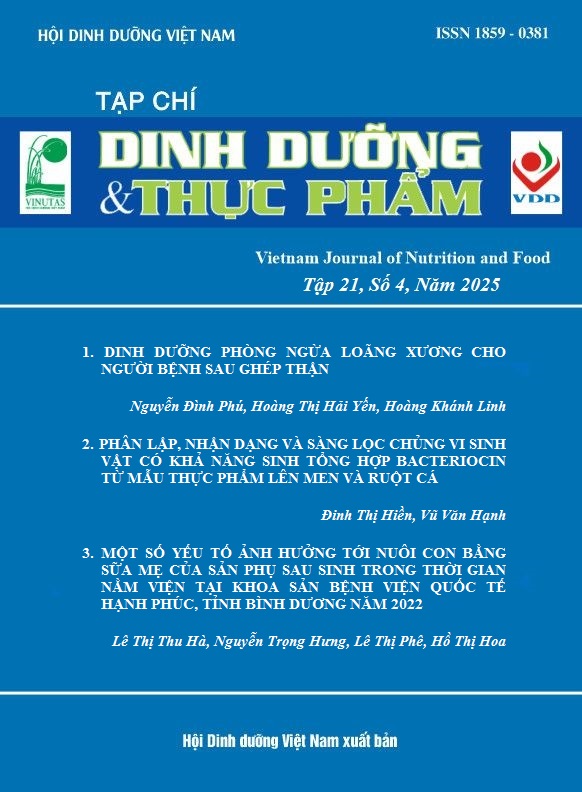24-HOUR DIETARY INTAKE OF HEAD AND NECK CANCER PATIENTS UNDERGOING TREATMENT AT NGHE AN ONCOLOGY HOSPITAL IN 2024
Main Article Content
Abstract
Aims: To evaluate the 24-hour dietary intake of head and neck cancer patients receiving treatment at Nghe An Oncology Hospital in 2024, aiming to determine the balance and adequacy of their energy and essential nutrient intake.
Methods: A cross-sectional descriptive study was conducted on 116 patients with head and neck cancer undergoing treatment at Nghe An Oncology Hospital. Dietary data were collected using a 24-hour dietary recall method through direct interviews. Nutrient composition was analyzed using NutriSurvey software and compared with recommended dietary requirements based on age and gender, according to guidelines from the National Institute of Nutrition.
Results: The proportion of patients meeting the recommended energy intake was 64.7%. The percentages of patients failing to meet the recommended intake for protein, fat, and carbohydrates were 49.1%, 23.3%, and 73.3%, respectively. Among male patients, the most prevalent vitamin deficiencies were vitamin PP (94.7%) and vitamin B1 (85.1%). Among female patients, deficiencies were primarily observed in vitamin B1 (95.5%), vitamin B2 (86.4%), and vitamin PP (86.4%). Furthermore, the proportions of patients not meeting the recommended intake of minerals such as calcium, iron, zinc, and magnesium were 82.8%, 91.4%, 46.6%, and 92.2%, respectively.
Conclusion: A considerable proportion of patients did not meet their recommended energy and nutrient intake. It is imperative for the hospital to implement individualized nutrition plans to provide patients with an adequate and balanced diet. The rates of patients failing to meet recommended dietary intake were alarmingly high, particularly for energy, protein, vitamins B1, PP, and minerals such as iron, calcium, and and magnesium. Therefore, personalized nutritional care should be prioritized in the clinical management of patients with head and neck cancer.
Article Details
References
2. CDC. Head and Neck Cancers Basics. Head and Neck Cancers. April 17, 2024. Accessed April 16, 2025. https://www.cdc.gov/head-neck-cancer/about/index.html
3. Sung H, Ferlay J, Siegel RL, et al. Global Cancer Statistics 2020: GLOBOCAN Estimates of Incidence and Mortality Worldwide for 36 Cancers in 185 Countries. CA Cancer J Clin. 2021;71(3):209-249. doi:10.3322/caac.21660
4. Nguyễn Thị Hương Quỳnh và cộng sự. Đánh giá tình trạng dinh dưỡng của người bệnh ung thư điều trị bằng hóa chất tại bệnh viên Quân y 103. Tạp Chí Khoa Học Điều Dưỡng. 2018;1(3):42-47.
5. Trần Thị Lan Phương. Tình trạn dinh dưỡng và khẩu phần của người bệnh tại khoa ung bướu, bệnh viện đa khoa tỉnh Điện Biên năm 2021-2022. Luận văn thạc sĩ dinh dưỡng. Đại học Y Hà Nội; 2022.
6. Phạm Khánh Huyền và cộng sự. Thực trạng và một số yếu tố liên quan đến tình trạng dinh dưỡng Pg-Sga của người bệnh ung thư đầu mặt cổ tại Bệnh viện Ung Bướu Nghệ An năm 2020. Tạp Chí Khoa Học Điều Dưỡng. 2020;3(5):198-207.
7. Nguyễn Thị Hằng và cộng sự. Đánh giá kết quả điều trị triệt để ung thư đầu cổ có phối hợp xạ trị trên người bệnh cao tuổi tại bệnh viện ung bướu Đà Nẵng. Tạp Chí Học Việt Nam. 2023;523(1). doi:10.51298/vmj.v523i1.4400
8. Trần Thị Lan Phương. Tình Trạng Dinh Dưỡng và Khẩu Phần Của Người Bệnh Ung Thư Tại Khoa Ung Bướu-Bệnh Viện Đa Khoa Tỉnh Điện Biên Năm 2021-2022. 2022.
9. Phạm Thị Hồng Chiên PTL. Tình trạng dinh dưỡng của người bệnh hóa-xạ trị ung thư hạ họng-thanh quản giai đoạn III-IV tại bệnh viện tai mũi họng trung ương. Tạp Chí Học Cộng Đồng. 2022;64(3).
10. Viện dinh dưỡng. Nhu Cầu Dinh Dưỡng Khuyến Nghị Cho Người Việt Nam. Nhà xuất bản Y học; 2016.
11. Tình trạng dinh dưỡng và khẩu phần ăn thực tế của người bệnh ung thư có điều trị bằng hóa chất tại bệnh viện phụ sản trung ương năm 2019-2020. Accessed April 16, 2025. https://tapchidinhduongthucpham.orvn/index.php/jfns/article/view/93/86
12. Surwillo A, Wawrzyniak A. Nutritional assessment of selected patients with cancer. Rocz Panstw Zakl Hig. 2013;64(3):225-233.


